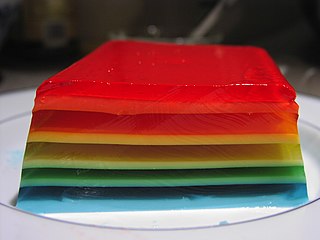
Gelatin desserts are desserts made with a sweetened and flavoured processed collagen product (gelatin). This kind of dessert was first recorded as jelly by Hannah Glasse in her 18th-century book The Art of Cookery, appearing in a layer of trifle. Jelly is also featured in the best selling cookbooks of English food writers Eliza Acton and Isabella Beeton in the 19th century.

Confectionery is the art of making confections, which are food items that are rich in sugar and carbohydrates. Exact definitions are difficult. In general, however, confectionery is divided into two broad and somewhat overlapping categories: bakers' confections and sugar confections. The occupation of confectioner encompasses the categories of cooking performed by both the French patissier and the confiseur.
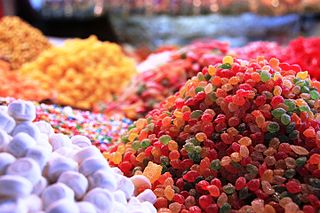
Candy, alternatively called sweets or lollies, is a confection that features sugar as a principal ingredient. The category, also called sugar confectionery, encompasses any sweet confection, including chocolate, chewing gum, and sugar candy. Vegetables, fruit, or nuts which have been glazed and coated with sugar are said to be candied.

A prune is a dried plum, most commonly from the European plum tree. Not all plum species or varieties can be dried into prunes. A prune is the firm-fleshed fruit (plum) of Prunus domestica varieties that have a high soluble solids content, and do not ferment during drying. Use of the term "prune" for fresh plums is obsolete except when applied to varieties of plum grown for drying.

"Junk food" is a term used to describe food that is high in calories from macronutrients such as sugar and/or fat, and possibly sodium, making it hyperpalatable, but with insufficient dietary fiber, protein, or micronutrients such as vitamins and minerals. It is also known as HFSS food. The term junk food is a pejorative dating back to the 1950s. Many variations of junk food can be easily found in most supermarkets and fast food restaurants. Due to easy accessibility, commercially-oriented packaging, and often-low prices, people are most likely to consume it.

Breakfast cereal is a breakfast food made from processed cereal grains. It is traditionally eaten as part of breakfast, or a snack food, primarily in Western societies.

Jelly beans are small bean-shaped sugar candies with soft candy shells and thick gel interiors. The confection is primarily made of sugar and sold in a wide variety of colors and flavors.

Candy corn is a small, pyramid-shaped candy, typically divided into three sections of different colors, with a waxy texture and a flavor based on honey, sugar, butter, and vanilla. It is a staple candy of the fall season and Halloween in North America.

Gummy bears are small, fruit gum candies, similar to a jelly baby in some English-speaking countries. The candy is roughly 2 cm (0.8 in) long and shaped in the form of a bear. The gummy bear is one of many gummies, popular gelatin-based candies sold in a variety of shapes and colors.

Golden Crisp, also known as Sugar Crisp in Canada, is a brand of breakfast cereal made by Post Consumer Brands that consists of sweetened, candy-coated puffed wheat and is noted for its high sugar content. It was introduced in the United States in 1948.
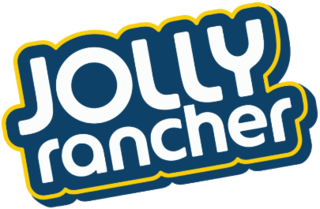
Jolly Rancher is an American brand of sweet hard candy, gummies, jelly beans, lollipops, sour bites, and a line of soda put out by Elizabeth Beverage Company in 2004. Originally created in Colorado in the 1950s, the Jolly Rancher brand has been owned by The Hershey Company since 1996.

Gumdrops are a type of gummy candy. They are brightly colored pectin-based pieces, shaped like a narrow dome, often coated in granulated sugar and having fruit and spice flavors; the latter are also known as spice drops.

Kid Cuisine is a brand of packaged frozen meals created in 1990 and is marketed by Conagra Foods. Described as a "frozen food version of a Happy Meal", the product is marketed towards children, while assuring parents of nutritional benefits. The mascot of the brand is a penguin named K.C., while the former was a different penguin named B.J. and a polar bear named "The Chef".

Fruit Roll-Ups is a brand of snack that debuted in grocery stores across America in 1983. It is a flat, corn syrup-based, fruit-flavored snack rolled into a tube, spread on a backing sheet of cellophane to prevent the product from sticking to itself.
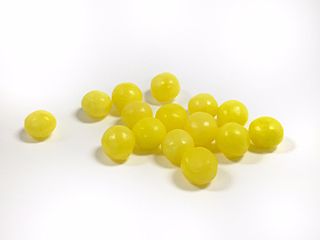
Lemonhead is an American brand of candy that was first introduced in 1962, produced by the Ferrara Candy Company. Lemonheads are a round, lemon-flavored candy consisting of a sweet coating, soft sour shell, and a hard candy core. Other popular flavors are Grapeheads, Cherryheads and Appleheads.
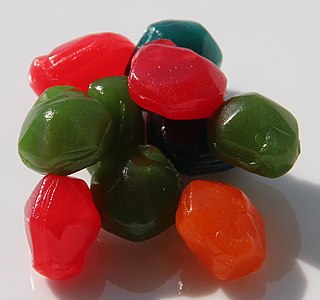
Fruit Gushers are a Betty Crocker-branded fruit snack introduced in 1991. They are soft and chewy with a fruity-juice center.

Gummies, gummi candies, gummy candies, or jelly sweets are a broad category of gelatin-based chewable sweets. Gummy bears, Sour Patch Kids, and Jelly Babies are widely popular and are a well-known part of the sweets industry. Gummies are available in a wide variety of shapes, most commonly seen as colorful depictions of living things such as bears, babies, or worms. Various brands such as Bassett's, Haribo, Albanese, Betty Crocker, Hersheys, Disney and Kellogg's manufacture various forms of gummy snacks, often targeted at young children. The name "gummi" originated in Germany, with the term "jelly sweets" more common in the United Kingdom.
In United States law, a food of minimal nutritional value is one that USDA has determined contain little to no nutritional value; these foods may not be sold in competition with the school lunch and breakfast programs. For example, sugar candy, soda pop without fruit juices, and chewing gum are considered to be foods of minimal nutritional value. Candy containing nuts or chocolate is considered to have some nutritional value.
Pará cuisine refers to the traditional cuisine native to Pará, Brazil. Foods from this region primarily draw influence from Indian, African, and Portuguese cultures. The core ingredients are sourced from the Amazon jungle, and may include meats such as shrimp, crab, seafood, fish, poultry, bush meat, and duck; these are all cooked with leaves, peppers, and herbs. Dishes are cooked in clay pots or barbecued in moquéns and soaked in tucupi, a yellow sauce extracted from wild manioc root native to the Amazon. Dishes may be served in bowls, in containers of clay, wrapped in cocoons of banana leaves, or in urupemas.
Gummy supplements, are dietary supplements delivered as gummy-candy-like products, most commonly comprising vitamins. They are often used as a more palatable alternative to other supplement formulations.

















